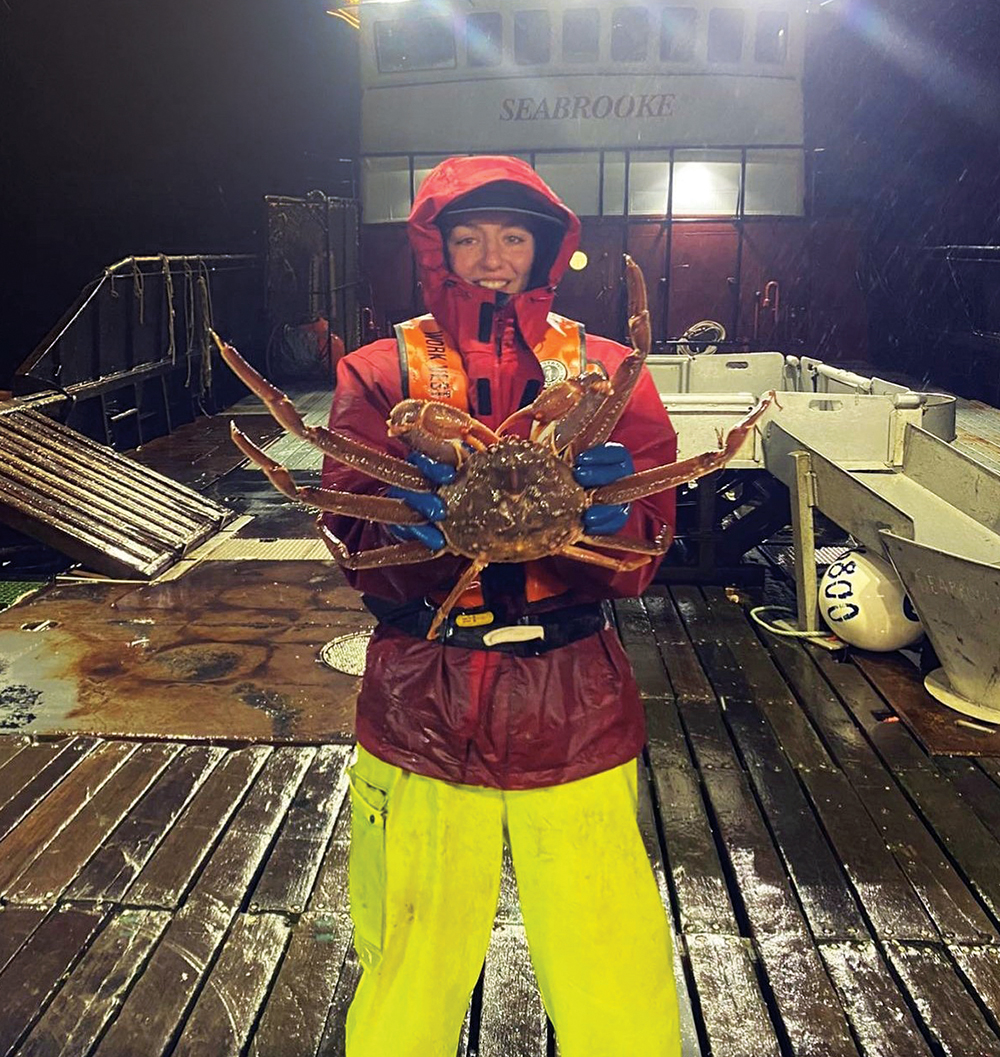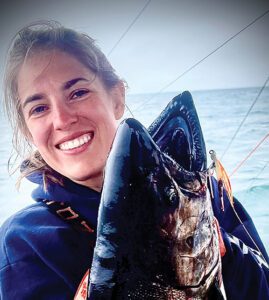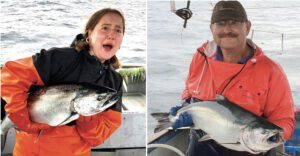
Twenty-one-year-old Megan Wallace of Kodiak readily admits that commercial fishing is a gamble, one involving hard work, long hours and yes, at times, danger.
“But I like how the hard work pays off,” she told Fishermen’s News. “It’s a great feeling when you catch a lot of fish.”
On a break from harvesting in mid-October, Wallace mused about the adventures she’s had of late. In 2021, Wallace spent 10 months crewing at sea, harvesting salmon in Bristol Bay, halibut in Area 4A near Dutch Harbor for halibut, Pacific cod in the Central and Western Gulf of Alaska, and then the Bering Sea A season for cod and the western Bering Sea for Bairdi crab.
“I just love everything about it, the challenge,” she said. “This is something a girl can do. I just love the rush and the whole process. My goal is to buy a boat and fish Bristol Bay.”
While Wallace’s enthusiasm for crewing on a commercial fishing boat is contagious, it has yet to produce the numbers demand of younger harvesters needed to step in as full-time fishermen.
Veteran fishermen like Eric Jordan of Sitka, in Southeast Alaska, wish there were more like her. Most of them, Jordan said, come out for the experience and then they get hooked and keep coming back, but are not interested in being full time fishermen.
Vessel captains, meanwhile, are looking for full time crew members, and maybe only 10% of those whom he has helped train are looking for a full time crewing job, Jordan said.
Obstacles to Entry
Three decades ago, a young person wanting to fish commercially needed a boat, some fishing gear and a sense of adventure to get started in the business, the Alaska Longline Fishermen’s Association (ALFA) notes in an online article focused on ALFA’s effort to help groom a new generation of fishermen and assure residents of Alaska’s coastal fishing communities access to their traditional fisheries.
Young people today face staggering entry level costs, high operating costs and a level of risk equivalent to buying a starter hotel, rather than a starter house, the association said.

Studies show that the average commercial fisherman these days is 50 years old, up by nearly a decade since 1980. There is also concern over fishery access permits and quota being lost in rural communities.
“Every year we have fishermen coming to us looking for crew,” Natalie Sattler, communications and program director for ALFA, said. “A lot of skippers want to teach the hands-on skills, conservation and policy,” Sattler said.
ALFA’s Young Fishermen Initiative, formalized in 2015, provides crew training to those with an interest in commercial fishing, and an opportunity to gain experience at sea. Its goal is to give young people an understanding of what commercial fishing is all about, the lifestyle it provides and its importance to the economy of coastal communities —all in a safe, well-guided entry level experience.
“Every year we get over 1,000 applicants,” Sattler said. “We can’t take them all. We also pass names of some of them on to skippers and they communicate with applicants. We have 15 or so who go out on boats. They are from all over. A lot of international as well.”
Jordan’s priority is finding local folks and matching them up with crew jobs, especially women.
“I am often the only one who calls them,” he said.
When his wife, who struggled with seasickness, retired about a decade ago as his fishing partner, his son encouraged him to share his knowledge by helping to train young fishermen. According to Jordan, a lot of captains don’t want female crews because they are worried about the risk of something going wrong, the dynamics of being out on the boat for five to seven days, and their wives complaining.
“I’m 72,” Jordan said. I’ve been married a long time. I’m not going to fool around with a woman younger than my kids. We don’t talk about sex. We are not out there having physical contact. I’m comfortable with it.”
“These women, they really want to go fishing,” he added. “I will do almost anything to help them. You come fishing with me and I will write letters of recommendation, but often they don’t see that as a way to make it a full time profession, because of the cost.”
Training Programs
ALFA and others, including the Alaska Marine Conservation Council (AMCC) and the Alaska Sea Grant Program, have spent a great deal of time and money on training programs to help young people learn the skills not just of crewing, but of the business of fisheries.
The Young Fishermen’s Summit, established in 2007 by the Alaska Sea Grant Marine Advisory Program, is a three-day networking and skill-building conference for new entrants in how to successfully manage modern commercial fishing businesses.
Participants get to network with other young fishermen from around the state, as well as fishing industry leaders. They also receive three days of training in the land-based aspects of running a fishing business, including marketing, business management, the fisheries regulatory process and the science of fisheries management.
The summit may also include field trips to legislative offices, hatcheries, laboratories, universities and management meetings.
For some, one of the challenges is having another job that allows them to take a couple of months off to fish, said Theresa Petersen, a veteran Kodiak harvester and fisheries policy director for AMCC, who has served on the North Pacific Fishery Management Council.
“You need a diversified source of income, multiple jobs that allow you to take time off to fish,” she explained.
Summer fisheries attract a lot of teachers who have the summer off from teaching, while other fishermen are exploring work ranging from kelp farming to making fishery-related sweatshirts, Petersen said.

Increasing Opportunities
Meanwhile, as the graying of the fleet continues and the cost of entry into commercial fishing continues to rise, commercial fisheries participants including ALFA have worked to achieve legislation like the Young Fishermen’s Development Act, modeled after similar agricultural programs which offers training funds and resources for the industry’s young participants.
The program provides funds for state, tribal, local or regionally based networks or partnerships that create training and educational opportunities in sustainable and accountable fishing practices, marine stewardship and business practices and technical initiatives addressing the needs for new fishermen.
Also included are mentoring and apprenticeship opportunities that connect retiring fishermen and vessel owners with those new to the profession, and financial support and guidance for young fishermen.
A national program providing increased opportunities for the next generation of commercial fishermen will be a groundbreaking step in protecting the stability of coastal fishing communities and America’s seafood supply chain, ALFA notes on its website.
More information about ALFA and AMCC and their networking efforts to provide mentorship and leadership development to draw more young people into commercial fishing careers is online at www.alfafish.org and www.akmarine.org.
